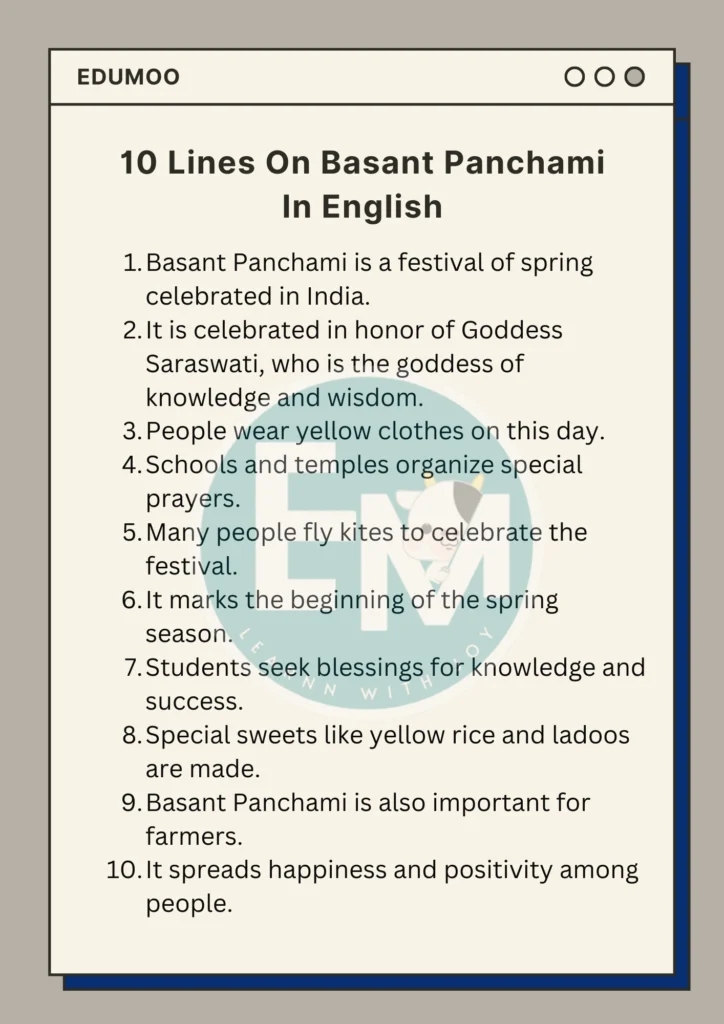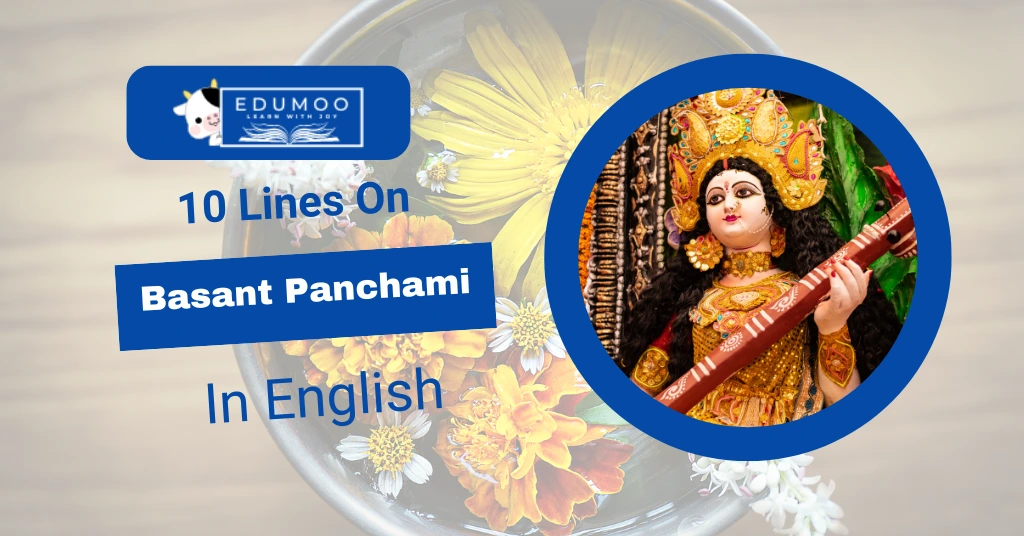Basant Panchami is a joyful festival celebrated in India to welcome the spring season. It is celebrated in honor of Goddess Saraswati, who is known as the goddess of knowledge and education. On this day, people wear yellow clothes, fly kites, and pray for knowledge and happiness. Schools and temples organize special prayers and cultural programs. Yellow sweets like ladoos and rice are made as part of the celebration. Let’s know more about this festival with 10 lines on basant panchami in english.
10 Lines On Basant Panchami In English
- Basant Panchami is a festival of spring celebrated in India.
- It is celebrated in honor of Goddess Saraswati, who is the goddess of knowledge and wisdom.
- People wear yellow clothes on this day.
- Schools and temples organize special prayers.
- Many people fly kites to celebrate the festival.
- It marks the beginning of the spring season.
- Students seek blessings for knowledge and success.
- Special sweets like yellow rice and ladoos are made.
- Basant Panchami is also important for farmers.
- It spreads happiness and positivity among people.

Essay On Basant Panchami In English In 200 Words
Basant Panchami is a famous festival in India that welcomes the beginning of the spring season. It is dedicated to Goddess Saraswati, who is known as the goddess of wisdom, learning, and music. People celebrate this day with great joy and devotion. Basant Panchami usually falls in January or February. It is an important day for students and teachers.
On this day, people wear yellow clothes because yellow is considered the color of energy and happiness. Many schools and colleges organize special prayers and cultural programs to honor Goddess Saraswati. Students pray for knowledge and success in their studies. People also prepare special yellow-colored food like sweet rice and ladoos.
One of the main attractions of Basant Panchami is kite flying. Many people, especially in North India, fly kites on this day. The sky looks beautiful with colorful kites flying high. This festival is also special for farmers because it marks the beginning of the harvest season. They pray for a good crop and prosperity.
Basant Panchami spreads happiness, wisdom, and positivity. It teaches us the importance of knowledge and growth in life. This festival is not just about prayers but also about enjoying nature and celebrating new beginnings. Basant Panchami brings people together and fills the environment with joy and hope.
Essay On Basant Panchami In English In 650 Words
Basant Panchami, also known as Vasant Panchami, is a vibrant festival celebrated across India, marking the onset of the spring season. The term ‘Basant’ translates to ‘spring,’ and ‘Panchami’ denotes the fifth day, indicating that this festival falls on the fifth day of the Hindu month of Magha, typically in January or February. This day is dedicated to Goddess Saraswati, the deity of knowledge, music, art, and wisdom. The festival holds immense significance, especially among students, artists, and musicians, as they seek the blessings of the goddess for success in their respective fields.
Basant Panchami heralds the arrival of spring, a season characterized by blooming flowers, pleasant weather, and renewed life. The mustard fields, especially in northern India, are adorned with yellow blossoms, painting the landscape in golden hues. This natural transformation symbolizes prosperity and the vibrancy of life. The festival is also associated with the worship of Goddess Saraswati. According to Hindu mythology, it is believed that on this day, the goddess was born, bringing knowledge and enlightenment to the world. Thus, devotees offer prayers to seek her blessings for wisdom and learning.
On Basant Panchami, devotees rise early to take ritualistic baths, donning new clothes, predominantly in shades of yellow. The color yellow holds special significance as it represents the brilliance of nature and the vibrancy of life. Homes and educational institutions set up altars or platforms to place idols or images of Goddess Saraswati. These are adorned with yellow flowers, and offerings such as sweets, fruits, and traditional delicacies are made. In many schools and colleges, students and teachers come together to perform Saraswati Puja, seeking blessings for academic excellence and the removal of obstacles in learning. Musical and cultural programs are organized, celebrating the arts that the goddess represents.
To delve deeper into the cultural aspects of Basant Panchami, you may find this resource helpful: Vasant Panchami – Wikipedia.
Food plays a pivotal role in Basant Panchami celebrations. A variety of traditional dishes are prepared, with a common theme of yellow hues to align with the festival’s color palette. Saffron-infused rice, known as ‘Kesari Chawal’ or ‘Meetha Pulao,’ is a popular delicacy. Sweet dishes like ‘Boondi ke Ladoo’ and ‘Kesar Halwa’ are also commonly prepared. In regions like Punjab, ‘Makki ki Roti’ (cornbread) and ‘Sarson ka Saag’ (mustard greens) are traditional favorites during this season. These culinary practices not only add flavor to the festivities but also symbolize the richness and prosperity of the harvest season.
While the core essence of Basant Panchami remains consistent, the modes of celebration exhibit regional diversity across India. In West Bengal and Odisha, the festival is celebrated with great fervor as Saraswati Puja. Students place their books and musical instruments near the goddess’s idol, refraining from using them until the rituals conclude, symbolizing a reverence for learning and the arts. In Punjab, the festival is synonymous with kite flying. The skies are dotted with colorful kites, and people engage in friendly competitions, adding a playful dimension to the celebrations. If you want to learn more about kite flying and its importance, check out this article on 10 Lines on Kite Festival. In Rajasthan, it is customary for people to wear jasmine garlands, and in Maharashtra, newly married couples visit temples and offer prayers on their first Basant Panchami after marriage, seeking blessings for a harmonious life.
Beyond the rituals and festivities, Basant Panchami holds a deeper cultural significance. It underscores the importance of knowledge, learning, and the arts in human life. The festival serves as a reminder of the continuous pursuit of wisdom and the need to appreciate the beauty of nature and creativity. By honoring Goddess Saraswati, devotees acknowledge the transformative power of education and the arts in shaping a harmonious and enlightened society.
Basant Panchami is a celebration that beautifully intertwines the reverence for knowledge with the joyous arrival of spring. It is a day when nature’s splendor is in full display, and the human spirit is uplifted through music, art, and learning. The festival encourages individuals to embrace wisdom, appreciate the arts, and celebrate the rejuvenating essence of spring. Through its diverse rituals and regional expressions, Basant Panchami exemplifies the rich cultural tapestry of India and the timeless value placed on knowledge and creativity.
Conclusion
Today, we have learnt 10 lines on Basant Panchami in English. Basant Panchami is a festival that brings joy, knowledge, and a fresh start. It reminds us of the beauty of spring and the importance of wisdom in life. Wearing yellow, flying kites, and offering prayers make this day very special. Students seek blessings for success, and families celebrate together with delicious food and cultural events. This festival spreads happiness and hope everywhere. Basant Panchami is not just a festival but a time to welcome positivity, new beginnings, and prosperity.

